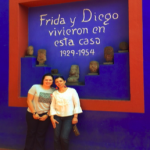Capítulo 4: Los pasatiempos
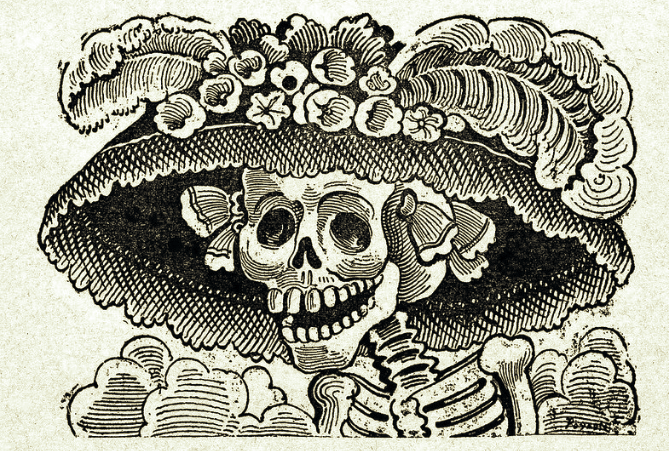
Sobre el artista: José Guadalupe Posada (1851-1913) was a printmaker whose work was influential in the development of XX-century graphic art. He became a kind of pictorial journalist with the publication of many illustrations and popular book and song covers. He is best known for his animated skeletons (calaveras), which are still used nowadays in the Day of the Death celebrations.
Learning Objectives
At the end of this chapter, students will be able to perform the following tasks in Spanish:
- I can talk about my pastimes and weekend activities
- I can talk about the movies and sports that I like
- I can talk about future plans
- I can discuss daily activities
Vocabulario
Pastimes / Sports / Board Games / Movies /Places
Pronunciación
Differences between J and G
Mosaicos culturales
Deportes populares
Estructuras gramaticales
4.1 The verb IR (to go)
4.2 Stem-Changing Verbs
4.3 Verbs with irregular YO forms
Escritura
Un día típico
Cultura
País: México
Música: Las variedades musicales de México
Personalidad: Frida Kahlo
Lectura
Cinco de mayo
Vocabulario: Los pasatiempos
| el equipo el partido ganar perder aficionado (a) |
team game; match to win to lose fan |
|---|
| Los deportes
el baloncesto |
Sports
basquetbol |
|---|
| Los pasatiempos acampar andar en bicicleta andar en patineta bucear correr escalar montañas esquiar hacer ejercicio ir de excursión ir de compras ir de pesca jugar al billar jugar a los bolos jugar videojuegos levantar pesas mirar televisión mochilear montar a caballo nadar pasear patinar pintar practicar deportes salir de copas textear tocar un instrumento tomar el sol trotar |
Pastimes
to go camping |
|---|
| Los deportes acuáticos
el buceo |
Water Sports
scuba dive |
|---|
| escribir un mensaje electrónico escribir una carta enviar un texto leer un periódico leer una revista revisar (checar) las redes sociales: Tik Tok o Instagram |
to write an email to write a letter to send a text to read a newspaper to read a magazine to check social media: Tik Tok or Instagram |
|---|
| El cine
las películas las películas de dibujos animados los boletos; las entradas |
Movies
movies tickets |
|---|

| Lugares
el café al aire libre |
Places
cafe outdoors |
|---|
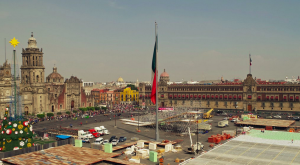
| ratos (tiempo)libre divertido/a |
spare (free) time fun |
|---|
| Juegos de mesa
ajedrez |
Board Games
chess |
|---|
| Verbos
almorzar (o:ue) |
Verbs
to have lunch |
|---|
ACTIVIDAD # 1
Categorías ¿Qué pasatiempos haces (you do) afuera (al aire libre) o adentro. Write next to the following activities where they normally take place: indoors or outdoors.
Afuera (al aire libre)-outdoors Adentro -indoors
- Jugar al fútbol
- Jugar al béisbol
- Ir de excursión( hacer senderismo)
- Nadar
- Mochilear
- Ver películas
- Jugar a las cartas
- Acampar
ACTIVIDAD # 2
Los deportes. Write the correct Spanish word for each picture.
| jugar tenis andar en bicicleta jugar hockey nadar levantar pesas
esquiar jugar golf jugar fútbol americano correr jugar fútbol |
|---|
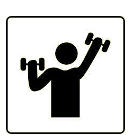 |
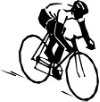 |
 |
 |
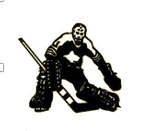 |
|---|---|---|---|---|
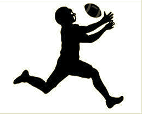 |
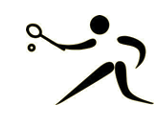 |
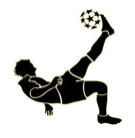 |
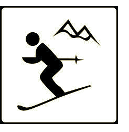 |
 ACTIVIDAD # 3
ACTIVIDAD # 3
GUSTAR – ¿Te gusta lo mismo? (Do you like the same?) From the following list of activities, sports, or pastimes, select those you like or don’t. Then, ask your classmate and compare your responses.
AGREEING: Me too/Me neither
DISAGREEING: I do/I don´t
|
|---|
TE GUSTA . . . Yo mi compañer@
me gusta no me gusta sí no
- Jugar videojuegos ____ ____ ____ ____
- Nadar ____ ____ ____ ____
- Escuchar música ____ ____ ____ ____
- Hacer ejercicio ____ ____ ____ ____
- Ver películas de horror ____ ____ ____ ____
- Andar en bicicleta ____ ___ ____ ____
- Escalar montañas ____ ____ ____ ____
- Tomar el sol ____ ____ ____ ____
- Mirar deportes en la televisión ____ ____ ____ ____
- Esquiar ____ ____ ____ ____
- Acampar ____ ____ ____ ____
- Armar rompecabezas ____ ____ ____ ____
ACTIVIDAD # 4
Find out how frequently your compañer@ do the following pastimes.
| siempre (always) con frecuencia (frequently)
dos veces por semana (two times a week) nunca (never) una vez por semana (once a week) a veces (sometimes) una vez al mes (once a month) una vez al año (once a year) |
|---|
Ejemplo:
E 1: ¿Con qué frecuencia juegas al golf?
E 2: Nunca juego al golf.
¿Con qué frecuencia. . . . . .
- andas en bicicleta?
- nadas en el mar?
- juegas un deporte? ¿cuál?
- corres?
- levantas pesas?
- vas (you go) de excursión? ¿adónde? VOY (I go) de excursion. . .
ACTIVIDAD # 5
¡Vamos a hablar! Practice the following questions with a partner.
Estudiante A
- ¿Te gusta practicar deportes? ¿Qué deporte prefieres practicar?
- ¿Cuál es tu equipo favorito?
- ¿Te gustan las actividades en el mar (océano)? ¿cuáles?
- ¿Te gusta jugar videojuegos o jugar a las cartas?
- ¿Tú tocas un instrumento musical? ¿Cuál?
- ¿Te gusta nadar?
Estudiante B
- ¿Qué deporte te gusta mirar en la televisión?
- ¿Cuál es tu pasatiempo favorito?
- ¿Te gustan las películas de horror?
- ¿Tú andas en bicicleta? ¿Por dónde te gusta ir?
- ¿Tú vas al cine los fines de semana?
- ¿Te gustan los deportes acuáticos?
ACTIVIDAD # 6
¿Qué haces en tu tiempo libre? ¿Cuáles son tus pasatiempos (aficiones) favoritos?
Y ahora ustedes. . .
- ¿Qué haces en tu tiempo libre?
Pronunciación
Diferencias de la letra J & G
| Pronunciación de la letra J j (jota)
ja- je- ji- jo- ju The Spanish j sound sounds like the h in the English word hit. Listen to your instructor and repeat the following words and phrases: ejemplo: José Juan jueves hija Japón jefe jirafa rojo reloj junio Julio y Juan trabajan el jueves. Mi hija quiere ir a Japón el próximo junio. |
|---|
| Pronunciación de la letra G (before e or i)
ge- gi When followed by e or i, the Spanish g sounds like the Spanish j (mentioned above). Listen to your instructor and repeat the following words and phrases: gila gente general Argentina geografía gigante gimnasio inteligente generoso Gerardo es muy inteligente y generoso. La gente de Argentina va al gimnasio. |
|---|
Mosaicos culturales: Deportes populares
Deportes populares. The most popular sport in Latin America and Spain is fútbol (soccer). However, some regions also prefer other sports:
| País or región | Deportes más populares |
|---|---|
| Panamá, Venezuela y todo el Caribe | El béisbol |
| Colombia | El ciclismo |
| México y Sur América | El fútbol (soccer) |
| Centro América | El boxeo |
| España | Baloncesto y fútbol |
Juegos menos populares. Certain games are unique to Latin America and Spain. Some of them even have origins that date back to pre-Columbian times. For example, in Mexico, expert swimmers dive on the high cliffs of Acapulco, while in Peru, the game of La Rana consists of trying to get a coin through the mouth of a frog.
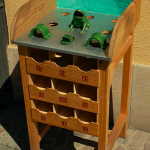
Y ahora ustedes…
- ¿Cuáles son los deportes más populares en tu estado (State)?
- ¿Qué juegos son menos populares en los Estados Unidos?
4.1 Gramática: The verb “IR” (to go)
| Singular | Plural | ||
|---|---|---|---|
| Yo | voy | Nosotros (as) | vamos |
| Tú | vas | Vosotros (as) | vais |
| Él, Ella, Usted | va | Ellos, Ellas, Ustedes | van |
- IR + a + Verb (infinitive) is used to tell what someone is going to do in the future.
Después de la clase, VOY a comer. El próximo verano, ellas VAN a estudiar en España.
After class, I am going to eat. Next summer, they are going to study in Spain.
- IR + a + place is used to tell where someone is going to go.
| Note: ir a la (feminine place) ir al (a + el) masculine place |
|---|
Después de la clase, VOY A LA biblioteca. El sábado, él VA AL gimnasio.
After class, I am going to the library. On Saturday, he is going to the gym.
- VAMOS + a + infinitive is used to express the idea of LET´S (do something).
¡Vamos a comer! Vamos a estudiar español.
Let’s eat! Let’s study Spanish.
Useful words and expressions to be used when talking about the future.
| Hoy | Today |
|---|---|
| Mañana | Tomorrow |
| Más tarde | Later |
| Esta tarde | This afternoon |
| Esta noche | Tonight |
| La semana que viene / la próxima semana | Next week |
| El mes que viene / el próximo mes | Next month |
| El año que viene / el próximo año | Next year |
| Mañana por la mañana | Tomorrow morning |
| Mañana por la tarde | Tomorrow afternoon |
| Mañana por la noche | Tomorrow night |
| El verano que viene / el próximo verano | Next summer |
ACTIVIDAD # 1
¿Adónde van? Using the following cues, say where these people are going. Use the appropriate conjugation of the verb IR + a + la, + al.
- Mis amigos / el parque
- Yo / restaurante Filibertos
- Ella / gimnasio
- Nosotros / clase de biología
- Tú / el partido (game) de fútbol americano
¡Inténtalo!
ACTIVIDAD # 2 Write-Pair-Share
Traducciones. Translate each of the sentences below.
1. We are going to the movies tomorrow.
______________________________________________.
2. She is going to play tennis next Saturday.
______________________________________________.
3. My friends are going scuba diving next summer.
______________________________________________.
4. I am going to the library after this class.
______________________________________________.
5. My friends and I are going hiking this weekend.
______________________________________________.
ACTIVIDAD # 3
Completar. Write in complete sentences what these people are GOING to do or GOING to go using the appropriate form of the verb IR.
1. ¿Adónde van ellos el viernes? Ellos _____________.
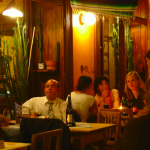
2. ¿Qué va a beber el niño? El niño ______________.

3. ¿Qué van hacer ustedes el sábado? Nosotros ____________.
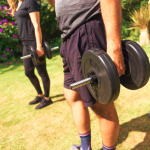
4. ¿Qué va hacer Antonio el fin de semana? Antonio ________.

5. ¿Adónde van ellos el domingo? Ellos ____________.
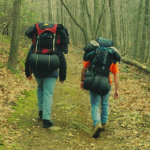
ACTIVIDAD # 4
¿Qué vas a hacer (to do). . . . .Answer the following questions using complete sentences.
- Después de la clase…..? _______________________________.
- Mañana por la noche…? _______________________________.
- En tus próximas vacaciones…? ___________________________.
- El próximo semestre…? ________________________________.
ACTIVITY # 5 ¡Hablemos!
With a partner, take turns asking and answering the following questions about your plans for the weekend.
Estudiante A
- El viernes por la noche, ¿Vas a salir con tus amigos?
- ¿Vas a trabajar el sábado?
- ¿Qué vas a hacer (to do) el sábado por la noche?
- ¿Qué vas a hacer el domingo por la mañana?
- ¿Dónde vas a comer el domingo por la noche?
Estudiante B
- ¿Qué vas a hacer (to do) el sábado por la mañana?
- ¿Vas a trabajar este (this) fin de semana?
- ¿Vas a comer en un restaurante?
- ¿Vas a estudiar el domingo?
- ¿Qué vas a hacer el viernes por la noche?
ACTIVIDAD # 6
Los planes después de la clase de español. Go around the room and find out what your classmates are going to do after class. Check Sí or No depending on the answer.
SÍ NO
- ¿Vas a comer? Ο Ο
- ¿Vas a otra clase? Ο Ο
- ¿Vas a tu casa? Ο Ο
- ¿Vas a estudiar en la biblioteca o en el café? Ο Ο
- ¿Vas a trabajar? Ο Ο
- ¿Vas a practicar algún deporte? Ο Ο
- ¿Vas a charlar con un amigo@? Ο Ο
- ¿Vas al gimnasio? Ο Ο
- ¿Vas a hacer (to do) tus tareas? Ο Ο
4.2 Gramática: Stem-Changing Verbs
E ⇒ IE Verbs
- Many verbs that contain an E in the stem will change to IE, EXCEPT the nosotros and vosotros forms.
CERRAR (to close)
| Singular | Plural | ||
|---|---|---|---|
| Yo | cierro | Nosotros (as) | cerramos |
| Tú | cierras | Vosotros (as) | cerráis |
| Él, Ella, Usted | cierra | Ellos, Ellas, Ustedes | cierran |
The following is a list of commonly used E:IE stem-changing verbs:
| Comenzar | to start / to begin | Perder | to lose / to waste / to miss (train, bus) |
|---|---|---|---|
| Confesar | to confess | Preferir | to prefer |
| Defender | to defend | Querer | to want / to wish / to love |
| Empezar | to begin | Referir | to refer |
| Entender | to understand | Sentir | to feel |
| Pensar | to think / to intend / to plan |
- The verbs comenzar and empezar require the preposition a when they are followed by another verb (infinitive)
Yo empiezo a trabajar a las tres de la tarde. I start working at three p.m.
- The verb Pensar can be followed by another verb in the infinitive to express planning or intending to do something. Pensar en means to think about someone or something. Pensar que means to think that.
Pienso comprar una casa. Pienso en mi familia. Pienso que la clase es fácil.
I plan to buy a house. I think about my family. I think that the class is easy.
- The verb Querer can be followed by another verb in the infinitive to express a wish or desire to do something.
Quiero ir a México. I want to go to Mexico.
ACTIVIDAD # 1
Oraciones. Conjugate the following stem-changing verbs accordingly:
1. Yo / cerrar la ventana por la noche.
________________________________________.
2. Susana y Luis / comenzar las clases en septiembre.
________________________________________.
3. El profesor de inglés / entender el español y el portugués
________________________________________.
4. Mi hermana / pensar que el español es difícil.
________________________________________.
5. Mi mamá / perder su teléfono celular todo el tiempo.
________________________________________.
¡Inténtalo!
ACTIVIDAD # 2
Contestar. Answer the following questions:
1. ¿Tú quieres comer pizza hoy?
_______________________________.
2. ¿Tus amigos piensan estudiar español?
_______________________________.
3. ¿Qué prefieres para beber: café o limonada?
_______________________________.
4. ¿Tú entiendes otra lengua además (besides) del español?
_______________________________.
5. ¿Tú piensas que Arizona es muy bonito?
_______________________________.
6. ¿En qué piensas normalmente?
_______________________________.
ACTIVIDAD # 3
Describir. Use a verb from the list and describe what these people are doing. Write a complete sentence, adding any necessary words.
|
entender querer cerrar empezar perder |
|---|

El chico |

La niña |
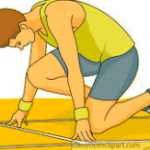
El atleta
|
|---|---|---|

El niño |
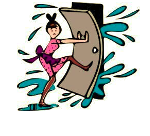
La señora
|
ACTIVIDAD # 4
With a partner, write the questions that originated the following answers:
- ________________________________________.
Ella piensa tomar la clase de español 102 el próximo semestre. - _______________________________________.
No, yo no entiendo el italiano. - ______________________________________.
Sí, nosotros preferimos mirar películas de acción. - _____________________________________.
Sí, yo defiendo a mi hermanito. - _____________________________________.
Yo quiero ir de excursión el domingo.
ACTIVIDAD # 5
¡Vamos a hablar! With a partner, practice the following questions.
Estudiante 1
1. ¿Prefieres la comida mexicana o china?
2. ¿Cuántas lenguas (idiomas) entiendes?
3. ¿Pierdes tus llaves (keys) frecuentemente?
4. ¿Piensas que hablar español es importante?
5. ¿Qué quieres hacer (to do) hoy?
Estudiante 2
1. ¿Prefieres beber agua o refrescos
2. ¿Entiendes japonés?
3. ¿A qué hora empieza la clase de español?
4. ¿Piensas mucho en tu futuro?
5. ¿Qué quieres comer hoy?
O ⇒UE Verbs
- Many verbs that contain an O in the stem will change to UE. EXCEPT the nosotros and vosotros form.
VOLVER (to return / to come back)
| Singular | Plural | ||
|---|---|---|---|
| Yo | vuelvo | Nosotros (as) | volvemos |
| Tú | vuelves | Vosotros (as) | volvéis |
| Él, Ella, Usted | vuelve | Ellos, Ellas, Ustedes | vuelven |
The following is a list of commonly used O: UE stem-changing verbs:
| Almorzar | to eat lunch | Mostrar | to show |
|---|---|---|---|
| Contar | to count / to tell | Poder | to be able to / can / may |
| Costar | to cost | Recordar | to remember |
| Devolver | to return something / give back | Resolver | to resolve |
| Encontrar | to find / to meet | Sonar | to sound / to ring |
| Morir | to die | Volver | to return / come back |
- The verb Poder can be followed by a verb in the infinitive to express the ability to do something.
Puedo ir a la fiesta. Ella puede nadar muy bien.
I can go to the party. She can swim very well.
- JUGAR (to play a sport or a game) is the only verb in Spanish that has a U: UE stem change.
- JUGAR is followed by AN ARTICLE when the name of the sport is mentioned.
Mi hermano juega al fútbol los fines de semana.
My brother plays soccer on the weekends.
Costar
- The verb “to cost” in Spanish is “Costar” and it should be used only in third person singular or third person plural.
- When asking someone for the price of ONE article regardless if it is feminine or masculine, you will say: ¿Cuánto cuesta?
- If you are asking for the price of more than one item, you will say: ¿Cuánto cuestan?
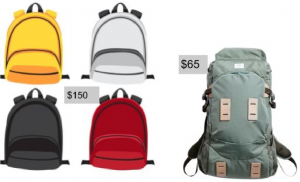
¿Cuánto cuestan las mochilas? Las mochilas cuestan ciento cincuenta dólares.
¿Cuánto cuesta la mochila? La mochila cuesta sesenta y cinco dólares.
ACTIVIDAD # 1
How much does it cost? With a classmate, select one item from the following picture at a time and ask for its price. Take turns.
| Vocabulario:
¿Cuanto cuesta. . .?
|
|---|
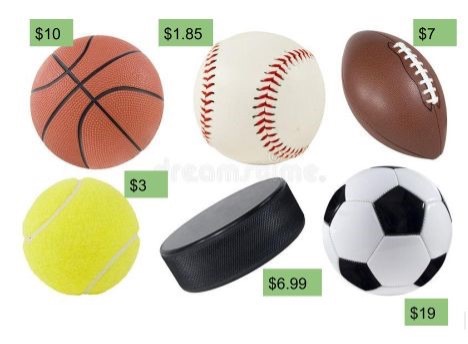
ACTIVIDAD # 2
Oraciones. Conjugate the following stem-changing verbs accordingly:
1. Mi madre / devolver el regalo.
__________________________________________.
2. Los estudiantes / volver a la clase de español mañana.
___________________________________________.
3. Nosotros / almorzar en la cafetería de la universidad.
___________________________________________.
4. Yo / encontrar libros en español en la biblioteca.
___________________________________________.
5. Alberto / dormir ocho horas por la noche.
__________________________________________.
¡Inténtalo!
ACTIVIDAD # 3
Completar. Select the appropriate O: UE stem-changing verb and write a sentence in the present tense that corresponds to the image.
|
Volar Contar Sonar Costar Mostrar Dormir |
|---|

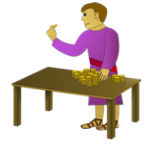
1. La mariposa__________. 2. Ella ___________el dinero.

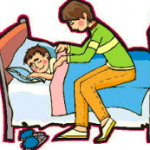
3. El profesor_________la gráfica. 4. El niño ___________mucho.

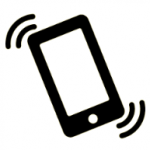
5. Los libros_________$83 dólares. 6. El teléfono___________.
ACTIVIDAD # 4
Situaciones. How would you express the following ideas in Spanish?
Pay attention to the O: UE stem-changing verbs:
1. Say that you don’t remember your house phone number.
_____________________________________________.
2. Ask your friend José what items he returns to the bookstore (librería).
______________________________________________.
3. Tell your teacher that you are not coming back to class tomorrow.
______________________________________________.
4. Ask a group of friends if they can hear the teacher.
_______________________________________________.
5. Say that you will show the class your personal pictures (photos).
_______________________________________________.
ACTIVIDAD # 5
With a partner, take turns asking and answering the following questions:
- ¿Dónde almuerzas todos los días?
- ¿Puedes jugar tenis?
- ¿Tú recuerdas los nombres de todos tus compañeros de clase?
- ¿Cuántas horas duermes normalmente?
- ¿Cuentas en inglés o en español?
- ¿A qué hora vuelves a tu casa los lunes?
E ⇒ I Verbs
- Many verbs that contain an E in the stem will change to I. Except for the nosotros and vosotros forms.
SERVIR (to serve)
| Singular | Plural | ||
|---|---|---|---|
| Yo | sirvo | Nosotros (as) | servimos |
| Tú | sirves | Vosotros (as) | servís |
| Él, Ella, Usted | sirve | Ellos, Ellas, Ustedes | sirven |
The following is a list of commonly used E: I stem-changing verbs:
| Conseguir | to obtain / to gain | Repetir | to repeat |
|---|---|---|---|
| Medir | to measure | Seguir | to follow |
| Pedir | to ask for / to request / to order (food or drinks) | Servir | to serve |
ACTIVIDAD # 1
Oraciones. Conjugate the following stem-changing verbs accordingly:
Ejemplo: Yo / conseguir los boletos de cine por internet.
Yo consigo los boletos de cine por internet.
1. Mis amigos / pedir tacos de pollo en el restaurante mexicano.
___________________________________________.
2. Yo / medir la distancia de mi casa a la universidad.
____________________________________________.
3. Los estudiantes / repetir el vocabulario en la clase de español.
____________________________________________.
4. Mi mamá / servir la comida en mi casa todos los días.
_____________________________________________.
5. ¿Tú / seguir las instrucciones del profesor?
_____________________________________________.
¡Inténtalo!
ACTIVIDAD # 2
Completar. Select the appropriate E: I stem-changing verb and write a sentence in the present tense that corresponds to the image.
| Medir Repetir Servir Seguir Pedir |
|---|
 La mesera______el desayuno.
La mesera______el desayuno. -
 Ellos ______la comida.
Ellos ______la comida. 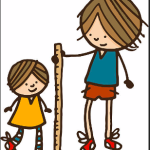 El niño________3 pies.
El niño________3 pies. 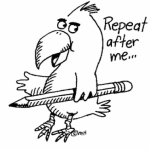 Los estudiantes________la lección.
Los estudiantes________la lección.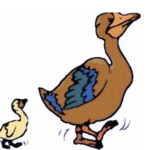 Los patitos (baby ducks) _________a su mamá.
Los patitos (baby ducks) _________a su mamá.
ACTIVIDAD # 3
With a partner, take turns asking and answering the following questions:
- ¿En un restaurante italiano, qué pides?
- ¿Quién sirve la comida en tu casa?
- ¿Tú les pides muchos favores a tus amigos?
- ¿Dónde consigues tu música normalmente?
- ¿Tú pides perdón (forgiveness) a menudo (often)?
- ¿Repites el vocabulario con frecuencia?
4.3 Verbs with irregular YO forms
- Some verbs in the YO form are also called GO verbs because the first-person conjugation ends in GO
Below are the most common GO verbs:
| *Hacer | Decir | *Poner | *Salir | Tener | Traer | |
|---|---|---|---|---|---|---|
| (to do, to make) | (to say) | (to put, to place) | (to leave) | (to have) | (to bring) | |
| Yo | haGO | diGO | ponGO | salGO | tenGO | traiGO |
| Tú | haces | dices | pones | sales | tienes | traes |
| El, Ella, Usted | hace | dice | pone | sale | tiene | trae |
| Nosotros(as) | hacemos | decimos | ponemos | salimos | tenemos | traemos |
| Vosotros(as) | hacéis | decis | ponéis | salis | tenéis | traéis |
| Ellos, Ellas, Ustedes | hacen | dicen | ponen | salen | tienen | traen |
- Hacer is often used to ask questions about what people are doing. When answering, HACER is frequently replaced with a specific action verb.
¿Qué haces ahora? Hablo por teléfono.
What are you doing now? I talk on the phone (I am talking on the phone).
- Poner can also mean TO TURN ON a household appliance.
Él pone la televisión. ¿Puedes poner la radio?
He turns on the television. Can you turn on the radio?
- Salir de is used to indicate that someone is leaving a place.
Salgo de mi casa a las 8 am. I leave my house at 8 am.
- Salir para is used to indicate someone´s destination.
Ella sale para California la próxima semana. She leaves for California next week.
- Salir con means to go out with someone, leave with something, or date someone.
Salgo con mis amigos los fines de semana. I go out with my friends on the weekends.
- Three other common verbs, which are irregular in the YO form but do not follow the above pattern, are DAR, VER, and OIR.
| Dar | Oír | Ver | |
|---|---|---|---|
| (to give) | (to hear) |
(to see) |
|
| Yo | DOY | OIGO | VEO |
| Tú | das |
oyes | ves |
| Él, Ella, Usted | da | oye | ve |
| Nosotros(as) | damos | oímos | vemos |
| Vosotros(as) | dáis | oís | veis |
| Ellos, Ellas, Ustedes | dan | oyen | ven |
ACTIVIDAD # 1
Fill in the blanks with the correct form of the appropriate verb.
Ejemplo: (Yo) traigo (salir, poner, traer) mi libro de español a la clase.
- (Yo) __________ (oir, traer, salir) música latina.
- (Yo) __________ (poner, ver, salir) mis libros en la mesa.
- (Yo) __________ (hacer, ver, dar) la tarea porque tengo un examen.
- (Yo) __________ nunca (tener, traer, decir) mentiras (lies).
- (Yo) __________ (ver, oír, hacer) películas en Netflix.
- (Yo) __________ (poner, traer, salir) de mi trabajo a las 6 pm.
¡Inténtalo!
ACTIVIDAD # 2
Describir Use the verbs from the given list to describe what the following people are doing.
| PONER SALIR HACER VER OIR |
|---|
 El perrito ____________ el correo en el buzón.
El perrito ____________ el correo en el buzón.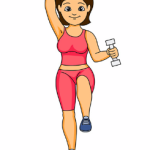 La chica ________________ ejercicio todos los días.
La chica ________________ ejercicio todos los días.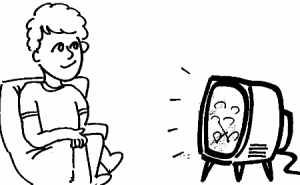 Yo _________ mucha televisión.
Yo _________ mucha televisión. 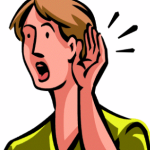 El chico NO ___________ bien.
El chico NO ___________ bien.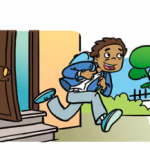 El niño ___________para la escuela.
El niño ___________para la escuela.
ACTIVIDAD # 3
Preguntas. With a compañero (a) practice asking and answering the following questions in complete phrases.
Ejemplo: ¿Traes tus libros a tus clases? Sí, TRAIGO mis libros a mis clases.
- ¿Ves deportes (sports) todos los fines de semana?
- ¿Traes una computadora a la clase de español?
- ¿Sales a comer con tu familia los fines de semana?
- ¿Oyes música mientras (while) estudias?
- ¿Haces mucha tarea para tus clases?
ACTIVIDAD # 4 Encuesta.
¿Con qué frecuencia. . . . (How frequently. . .?)
Paso 1: Read the following statements and mark with an (X) how often you do them.
| Yo… | Generalmente | Casi nunca | Nunca | Mi compañero (a) |
|---|---|---|---|---|
| (on a regular basis) | (rarely) | (never) | ||
| 1. Hago mis tareas por la noche | ||||
| 2. Digo que el español es fácil | ||||
| 3. Pongo mis libros en la mesa | ||||
| 4. Salgo todos los sábados al parque | ||||
| 5. Doy fiestas de Halloween | ||||
| 6. Veo películas en Netflix | ||||
| 7. Oigo música Hip-Hop y Rap | ||||
| 8. Traigo mucho dinero en mi cartera (wallet) | ||||
| 9. Traigo mi teléfono a clase |
Paso 2: Change the statements above to questions to interview a classmate. Write your findings in the box ¨mi compañero (a)¨
Ejemplo:
- ¿Con qué frecuencia HACES tus tareas por la noche?
ACTIVIDAD # 5
¡Vamos a hablar! With a partner, take turns asking and answering the following questions.
Estudiante A
- ¿Ves películas en tu casa o prefieres ir al cine?
- ¿A qué hora sales de tu casa el lunes?
- ¿Haces mucha tarea los fines de semana?
- ¿Te gusta ver deportes por televisión o prefieres ver otros programas? ¿Cuáles?
- ¿Qué traes a la clase de español?
- ¿Oyes música en tu carro? ¿Qué tipo de música te gusta escuchar?
Estudiante B
- ¿Qué traes a la clase de español?
- ¿Haces mucha tarea los fines de semana?
- ¿Oyes música cuando estudias?
- Sales con tus amigos los fines de semana? ¿Adónde?
- ¿Qué prefieres hacer, oír música o ver la tele?
- ¿Dónde pones tus libros?
Escritura: Un día típico
Write a paragraph describing a typical day in your life.
Guidelines:
- Need a title: Un día típico /Mi día típico / Un lunes típico
- Need to have at least 10 verbs (at least four (4) from capítulo 4)
- Need to have sequencing or transitional words:
•Por último (lastly)
El miércoles, primero, DESAYUNO a las siete y media. Luego, HAGO mi café y BEBO mi café. Después de beber el café, VOY al gimnasio a levantar pesas y a correr. Más tarde, COCINO comida para el almuerzo. Después del almuerzo, VOY al parque con mi amiga y HABLAMOS. Me gusta caminar en el parque. A las seis y media, mi esposo y yo PREPARAMOS la cena. Después de la cena, VEO la televisión y LEO mi libro. Por último, DUERMO a las once de la noche.
Cultura: México
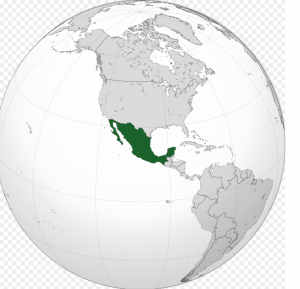
Capital: Ciudad de México Ciudades importantes: Guadalajara Datos curiosos:
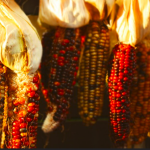 |
|---|
Música: Las variedades musicales de México
Ballet Folklórico México Danza – La Bamba (Veracruz)
There are several styles of Mexican music that vary according to the region in which they originated. Mexican music is a blend of traditional indigenous rhythms and Spanish influences. Mariachi music is perhaps the most renowned around the world to represent Mexico. Mariachi music originated in the State of Jalisco, blending traditional Spanish music with local influences to create the famous “rancheras.” The Northern states of Mexico experienced significant influence from the USA, particularly in the form of “Tejano” music, a blend of traditional Texan music and Mexican folklore. One of the instruments that brought a new tradition to the north was the accordion, which was later mixed with local melodies to create the popular “Norteña” music. Each region of Mexico is also represented by various types of dances, such as the “Son Jarocho” (La Bamba) and “Danzón” on the Eastern coast of Mexico (which also integrates the harp) or the “Jarabe Tapatío”, widely popular throughout the world.
Activity. Please select Verdadero (V) or Falso (F) according to the reading. If the statements are false, please correct them.
- Mariachi is the most popular music to represent Mexico around the world. (V) (F)
- A “Ranchera” is a ballad with influences from Spain. (V) (F)
- “Tejano” refers to a blend of music from northern Mexico and traditional Mexican music. (V) (F)
- “Son Jarocho” is traditional music from the Mexican Caribbean coast. (V) (F)
- The Accordion and the Harp are two instruments commonly associated with Mexican music. (V) (F)
Personalidad: Frida Kahlo
Press play to listen to the pronunciation of the reading in the paragraph written below.
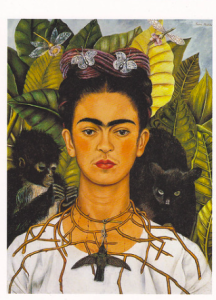 |
Tour Virtual (click here) |
Preguntas de Comprensión. After reading the short biography of Frida Kahlo,
answer the following questions.
1. ¿Cuál es el estilo de arte de Frida?
_____________________________________.
2. ¿Qué tipo de cuadros (paintings) pinta Frida?
_________________________________.
3. ¿Cómo se llama el museo de Frida?
__________________________________.
4. ¿Te gusta el arte? ¿Cuál es tu artista favorito/a?
____________________________________.
Lectura: Cinco de mayo
Fact or fiction?
- Cinco de Mayo is not Mexico’s Independence Day (it is actually September 16). It is the celebration of the Battle of Puebla, when Gen. Ignacio Zaragoza led a poorly armed group of mestizos and Zapotecs to victory against the French (Napoleon III’s forces) in 1862.
- Cinco de Mayo is NOT a national Mexican holiday. It is mainly celebrated in Puebla, where the battle took place.
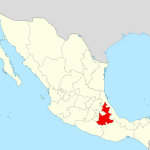
4. The victory didn’t last long. A year later, Napoleon III sent troops back, and they took control of Mexico, including Mexico City. The French were in power from 1864 to 1867.
5. Maximilian (French) ruled Mexico during this time period, but then Napoleon III withdrew his support, and the United States started to come to the aid of Mexico. Maximilian was eventually imprisoned and then killed.
Falso o Cierto
1. El cinco de mayo es el día de la independencia de México.
2. El cinco de mayo es un día feriado (holiday) en México.
3. A year later, the French took control of México.

